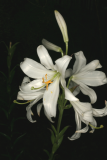Additional notes (click to expand)
Medicinal
Culpeper (1649, and 1650): “The root ... helps burnings, softens the womb, provokes the terms; if boiled in wine it is given with good success in rotten fevers, pestilences, and all diseases that require suppuration: (it being outwardly applied) helps ulcers in the head, and amends the ill colour of the face.”
Culpeper, Nicholas. (1650). A Physical Directory . London, Peter Cole.
Notes: The College Pharmacopeia (sic) of 1618 lists this under ‘flowers’, but Culpeper has it under ‘roots’
(1618). Pharmacopeia Londinensis Facsimile 1618. The Royal College of Physicians, London.
In traditional medicine L. candidum, the Madonna lily, has a long history of herbal use, though it is seldom employed in modern herbalism because of its scarcity. The bulb and the flowers are astringent, highly demulcent, emmenagogue, emollient and expectorant. The plant is mainly used externally, being applied as a poultice to tumours, ulcers, external inflammations etc. The bulb is harvested in August and can be used fresh or dried. The flowers are harvested when fully open and used fresh for making juice, ointments or tinctures[Bown. D. Encyclopaedia of Herbs and their Uses. Dorling Kindersley, London. 1995]. The pollen has been used in the treatment of epilepsy[Chopra. R. N., Nayar. S. L. and Chopra. I. C. Glossary of Indian Medicinal Plants (Including the Supplement). Council of Scientific and Industrial Research, New Delhi. 1986].
https://pfaf.org https://pfaf.org/User/plant.aspx?latinname=Lilium+candidum
Lilium candidum L.
Family: LILIACEAEGenus: Lilium
Species: candidum L.
Common names: Madonna Lily
Pharmacopoeia Londinensis name: Lilium
Distribution summary: S.W.Europe & S.W.Asia
Habit: Perennial
Hardiness: H5 - Hardy; cold winter
Garden status: Not currently grown
